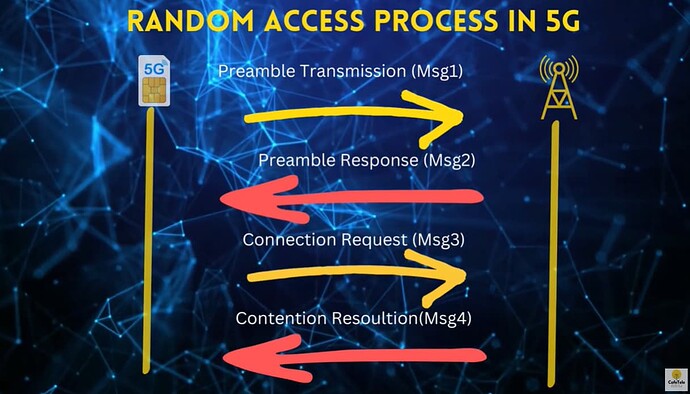In 5G networks, random access procedures are crucial for establishing initial communication between a User Equipment (UE) and the network, especially in scenarios such as initial network access, handovers, and when the UE needs to move from an idle to a connected state.
The random access process ensures that the UE can synchronize with the network and obtain the necessary resources for data transmission.
Random Access Procedure in 5G
The random access procedure in 5G is a bit different compared to previous generations due to its enhanced capabilities and applications. However, it adheres to the fundamental steps which are common in cellular technologies. Below are generalized steps in the 5G random access procedure:
-
Preamble Transmission (Msg1): The UE selects a random access preamble from a set provided by the gNB (5G Node B or base station).
- The UE sends the selected preamble to the gNB using a Random Access Channel (RACH).
-
Random Access Response (Msg2): Upon receiving the preamble, the gNB sends a Random Access Response (RAR) to the UE.
- RAR contains a Timing Advance (TA) command to adjust the UE’s timing, and initial uplink resources for the UE to send further messages.
-
RRC Connection Request (Msg3): The UE sends a connection request message using the resources granted in the RAR.
- This message contains the UE’s identity and the reason for the establishment (e.g., initial access, handover, etc.).
-
Contention Resolution (Msg4): The gNB sends a Contention Resolution message, which confirms the UE’s identity and establishes that the random access procedure has been successful.
Types of Random Access Procedures in 5G:
-
Contention-Based Random Access (CBRA): It is similar to the traditional random access process as discussed in the generalized steps above.
- The UE selects a preamble randomly, and there is a possibility of contention (collision) if another UE selects the same preamble.
The contention is resolved during the contention resolution process (Msg4).
- The UE selects a preamble randomly, and there is a possibility of contention (collision) if another UE selects the same preamble.
-
Contention-Free Random Access (CFRA): The gNB assigns a dedicated preamble to the UE, ensuring that there are no collisions during the random access process.
- It is used in scenarios where guaranteed access is required, such as handovers or when the UE has data to transmit in the uplink that the network is aware of.
5G Enhancements and Challenges:
5G introduces various enhancements and supports numerous use cases (e.g., Ultra-Reliable Low Latency Communications (URLLC), Enhanced Mobile Broadband (eMBB), Massive Machine Type Communications (mMTC)). These diverse use cases with different requirements (like latency, reliability, and data rates) pose challenges in the design of random access procedures.
-
Scalability: The random access procedure must be scalable to accommodate many devices, especially in mMTC scenarios.
-
Reliability and Latency: For URLLC, the random access procedure must be reliable and support low-latency communication.
-
Resource Efficiency: Efficient utilization of radio resources during the random access procedure is crucial to ensuring network performance.
Watch on YouTube: ![]() https://www.youtube.com/watch?v=kg-eNiASXTg
https://www.youtube.com/watch?v=kg-eNiASXTg
